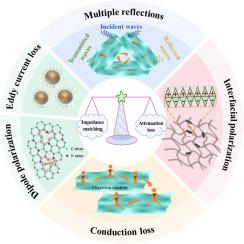壳聚糖/MIL-88A衍生氮掺杂碳/氧化铁/碳复合电磁波吸收和隔热气凝胶的制备
IF 11.6
2区 材料科学
Q1 CHEMISTRY, PHYSICAL
引用次数: 0
摘要
生物碳基电磁波吸收剂因其资源丰富、环境友好而受到广泛关注。然而,它们的阻抗失配和单一衰减机制对实现高效的EMW吸收性能构成了严峻的挑战。本文采用水热反应、冷冻干燥和高温碳化三步法制备了壳聚糖/MIL-88A衍生的氮掺杂碳/三氧化三铁/碳(NC/Fe3O4/C)复合气凝胶。结果表明,三维多孔网络结构和丰富的异质界面有利于增强界面极化和优化阻抗匹配。此外,介质损耗和磁损耗的协同作用使NC/Fe3O4/C复合气凝胶在炭化温度为700℃、填充率为17 wt%时具有优异的EMW吸收性能。当厚度为2.94 mm时,最小反射损耗为- 70.91 dB。将厚度优化至2.8 mm后,最大有效吸收带宽可达7 GHz,超过了目前报道的大多数生物碳基EMW吸收材料。此外,制备的NC/Fe3O4/C复合气凝胶也表现出良好的保温性能。雷达截面模拟研究结果表明,所制备的复合气凝胶具有良好的雷达波耗散能力。本研究为促进生物碳基多功能EMW吸收剂的发展提供了创新的见解。本文章由计算机程序翻译,如有差异,请以英文原文为准。

Fabrication of chitosan/MIL-88A derived nitrogen-doped carbon/ferroferric oxide/carbon composite aerogels for electromagnetic wave absorption and thermal insulation
Biological carbon-based electromagnetic wave (EMW) absorbers have attracted much attention due to their abundant resources and environmental friendliness. However, their impedance mismatch and single attenuation mechanism pose severe challenges to achieving efficient EMW absorption performance. In this work, chitosan/MIL-88A derived nitrogen-doped carbon/ferroferric oxide/carbon (NC/Fe3O4/C) composite aerogels were prepared by a three-step method of hydrothermal reaction, freeze-drying and high-temperature carbonization. The results revealed that the three-dimensional porous network structure and the rich heterointerfaces were conducive to enhancing interfacial polarization and optimizing impedance matching. Furthermore, the synergistic effect of dielectric loss and magnetic loss enabled the NC/Fe3O4/C composite aerogel with excellent EMW absorption performance at the carbonization temperature of 700 °C and a filling ratio of 17 wt%. When the thickness was 2.94 mm, the minimum reflection loss was −70.91 dB. After optimizing the thickness to 2.8 mm, the maximum effective absorption bandwidth could reach 7 GHz, surpassing that of most reported biological carbon-based EMW absorbers. Additionally, the prepared NC/Fe3O4/C composite aerogel also exhibited good thermal insulation property. The research results of radar cross section simulation manifested that the obtained composite aerogels possessed excellent radar wave dissipation capability. This study provides innovative insights, aiming to promote the development of biological carbon-based multifunctional EMW absorbers.
求助全文
通过发布文献求助,成功后即可免费获取论文全文。
去求助
来源期刊

Carbon
工程技术-材料科学:综合
CiteScore
20.80
自引率
7.30%
发文量
0
审稿时长
23 days
期刊介绍:
The journal Carbon is an international multidisciplinary forum for communicating scientific advances in the field of carbon materials. It reports new findings related to the formation, structure, properties, behaviors, and technological applications of carbons. Carbons are a broad class of ordered or disordered solid phases composed primarily of elemental carbon, including but not limited to carbon black, carbon fibers and filaments, carbon nanotubes, diamond and diamond-like carbon, fullerenes, glassy carbon, graphite, graphene, graphene-oxide, porous carbons, pyrolytic carbon, and other sp2 and non-sp2 hybridized carbon systems. Carbon is the companion title to the open access journal Carbon Trends. Relevant application areas for carbon materials include biology and medicine, catalysis, electronic, optoelectronic, spintronic, high-frequency, and photonic devices, energy storage and conversion systems, environmental applications and water treatment, smart materials and systems, and structural and thermal applications.
 求助内容:
求助内容: 应助结果提醒方式:
应助结果提醒方式:


